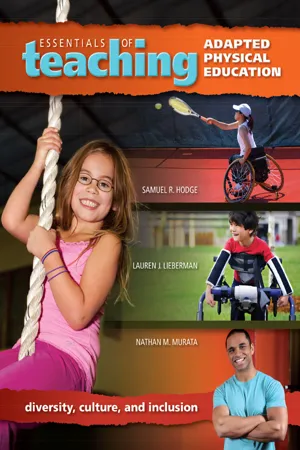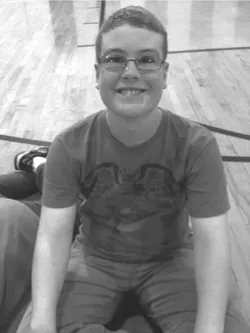
Essentials of Teaching Adapted Physical Education
Diversity, Culture, and Inclusion
- 432 pages
- English
- ePUB (mobile friendly)
- Available on iOS & Android
Essentials of Teaching Adapted Physical Education
Diversity, Culture, and Inclusion
About this book
Essentials of Teaching Adapted Physical Education: Diversity, Culture, and Inclusion offers a wealth of knowledge for teaching today's diverse student population, including those with disabilities. Readers will learn how to teach a variety of students, organize learning within various curricular models, assess and evaluate students, and manage behavior. Readers will also learn more about the conditions and disabilities they may encounter when teaching, how to understand students' various abilities, and how to adapt and modify instructional methods to include all students.
The book emphasizes the importance of being culturally responsive and acquiring the necessary knowledge to infuse appropriate, socially just practices into educational settings. Future teachers will learn how to apply culturally responsive instructional methods and behavior management strategies and will understand broader social and economic contexts for their students' behavior.
At the same time, this book provides more than a how-to approach to teaching adapted physical education. Its content and features promote reflective learning, encouraging readers to anticipate the types of teaching situations and challenges that may arise and think through how they will respond. Scenarios and vignettes throughout provide context for the material and promote critical thinking and problem solving.
Frequently asked questions
- Essential is ideal for learners and professionals who enjoy exploring a wide range of subjects. Access the Essential Library with 800,000+ trusted titles and best-sellers across business, personal growth, and the humanities. Includes unlimited reading time and Standard Read Aloud voice.
- Complete: Perfect for advanced learners and researchers needing full, unrestricted access. Unlock 1.4M+ books across hundreds of subjects, including academic and specialized titles. The Complete Plan also includes advanced features like Premium Read Aloud and Research Assistant.
Please note we cannot support devices running on iOS 13 and Android 7 or earlier. Learn more about using the app.
Information

1
Education and Students with Disabilities
How should a physical education teacher best prepare for and respond to such a common situation? Generally speaking, many teachers ask “How can I most effectively teach students with disabilities?” In this chapter, we discuss physical education for students with disabilities.
Overview of Disability
More than one billion people in the world live with some form of disability, of whom nearly 200 million experience considerable difficulties in functioning. In the years ahead, disability will be an even greater concern because its prevalence is on the rise. This is due to ageing populations and the higher risk of disability in older people as well as the global increase in chronic health conditions such as diabetes, cardiovascular disease, cancer and mental health disorders.Across the world, people with disabilities have poorer health outcomes, lower education achievements, less economic participation and higher rates of poverty than people without disabilities. This is partly because people with disabilities experience barriers in accessing services that many of us have long taken for granted, including health, education, employment, and transport as well as information. These difficulties are exacerbated in less advantaged communities. (p. xi)

Table of contents
- Cover
- Title Page
- Copyright Page
- Table of Contents
- Preface
- Acknowledgments
- About the Authors
- 1 Education and Students with Disabilities
- 2 Teaching a Diversity of Learners
- 3 Physical Activity and Health
- 4 Motor Development
- 5 Inclusive Curricular Models and Instructional Methodology
- 6 Assessment and Individualized Education Program Development
- 7 Managing the Environment and Student Behavior
- 8 Support Personnel in Physical Education
- 9 Obesity
- 10 Learning Disabilities
- 11 Intellectual Disabilities
- 12 Motor Delays and Developmental Coordination Disorder
- 13 Visual Impairments, Deafness, Hard-of-Hearing, or Deafblindness
- 14 Autism Spectrum Disorders
- 15 Other Health Impairments
- 16 Teaching Students with Severe or Multiple Disabilities
- 17 Assistive Technology and Assistive Devices in Physical Education
- Glossary
- Author Index
- Subject Index